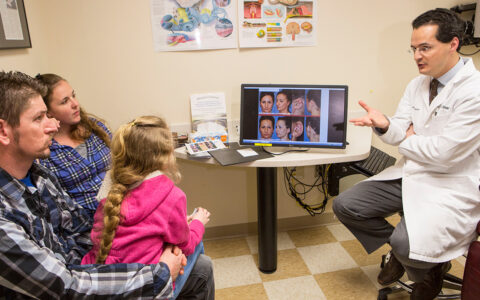Craniofacial clefts – primarily cleft lip and cleft palate – are among the most common congenital abnormalities encountered today. Maternal nutrition, obesity, race, ethnicity, heredity, environment, and healthcare access all can have a significant impact on their prevalence, but regional data has been lacking to describe these relationships and better direct resources.
“We know that craniofacial defects often correlate with prenatal factors during the first nine weeks of gestation, such as taking prenatal vitamins (e.g., folic acid), coming in for scheduled exams, eating a nutritious diet, eliminating alcohol, tobacco or harmful medications, and controlling maternal diabetes,” said Ryan H. Belcher, M.D., an assistant professor of otolaryngology-head and neck surgery at Vanderbilt University Medical Center.
The study also demonstrated a significant negative correlation between CP prevalence rates and median household income.
“Out of all the studies that have looked at socioeconomic statuses for cleft, this is the first one that we know of that shows an association between income and cleft development,” Belcher said.
Published in the International Journal of Pediatric Otorhinolaryngology, Belcher and colleagues provide a model for states to better analyze their regional data and draw associations. They compiled data on 13 regions in Tennessee, describing factors likely to affect prevalence rates for cleft lip with or without cleft palate (CL ± P), and cleft palate without cleft lip (CP). Together, these two congenital anomalies constitute most craniofacial defects.
Tennessee has rich data on congenital birth anomalies by region gathered since the year 2000. Belcher used this resource, in conjunction with national data, to paint the landscape of risk for these events.
“We found an overall drop in craniofacial defect rates over this entire period, but concentrations of significantly higher rates in certain regions,” Belcher said. “Understanding risk factors by region in diverse states like ours is important for directing prevention strategies and enhanced resources to the areas most in need.”
Temporal Breakdown of Data
Belcher and colleagues compared the data between two time periods: 2000-2008 and 2009-2017.
The demarcation is significant for marking the beginning of CDC recommendations for regional tracking of craniofacial defects, as well as when Tennessee banned indoor smoking and the state began collecting data as part of the Pregnancy Risk Assessment Monitoring System, an initiative that promotes early intervention in pregnancies to help prevent defects and morbidities.
There were 1,457,706 babies born in Tennessee between 2000 and 2017, with 2,555 having a craniofacial defect. Notably, the rate per 10,000 live births dropped from 18.2 between 2000-2008 to 16.9 between 2009-2017.
“In almost all 13 regions, there was some decrease in the rate of clefts overall between the two periods, as well as over the entire 17 years,” Belcher said.
In addition, there was significant regional variance, from as low as 12.7 craniofacial defects per 10,000 live births in the Shelby County region (encompassing Memphis), to as high as 23.2 per 10,000 in the mid-state Upper Cumberland region.
“Several regions in Eastern and Northern Tennessee include rural Appalachian areas where there is a high population of Caucasian individuals, many people living in poverty, and a less diverse gene pool than most regions. All of these factors raise the risks,” Belcher said.
Nevertheless, in one of those regions, East Tennessee, researchers found the largest drop in cases over the 17 years. Belcher says the study does not address the reasons, but they may include increased urbanization, improved access to care and genetically similar families moving out of the region.
“Understanding risk factors by region in diverse states like ours is important for directing prevention strategies and enhanced resources to the areas most in need.”
Demographic Predictors of Higher Rates
Regional statistics within racial/ethnic groups showed that the prevalence of craniofacial defects is almost twice as high as in Caucasian populations compared to other racial/ethnic groups evaluated in the study, which were about equal to one another.
As an example, Shelby County, which has the highest percentage of African Americans in the state, has the lowest rates. All the regions containing large urban areas had smaller non-Hispanic white populations and lower prevalence.
Epidemiologic studies show a higher prevalence of CP in females versus males, with the Tennessee data reflecting this trend. Belcher says different timing of gestational craniofacial development in males compared to females may be a contributing factor. In contrast, males have slightly higher rates of CL ± P compared to females.
Advancing Care in Tennessee
Craniofacial defects can pose major public health issues, especially in areas with limited surgical and medical resources. Even children who are treated appropriately, including having surgery within 12 months of birth, still face significant burdens in life, including increased risk of psychiatric conditions and suicide and increased all-cause mortality.
At Vanderbilt, care of these patients goes beyond surgery to include surgical follow-up and ongoing treatment from audiology, speech therapy, care coordinators, dentists, geneticists, and social work specialists. The team recently received a $1 million endowment from Delta Dental for the advancement of this care.






